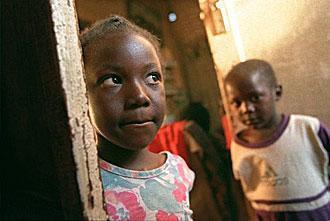RUTH'S MOTHER already knows.
She sits at the foot of her daughter's bed, legs tucked beneath her long skirt, hands resting lightly on the blanket, head bowed. A red kerchief binds her hair.
 |
| BETTY UDESEN / THE SEATTLE TIMES |
| Martha and Tafadzwa, the day before their mother died. |
|
 |
 |
Consolota Njawara Chimuonenji has borne and raised seven daughters and five sons. The youngest is 11-year-old Ireen; Catherine, at 33, is the oldest. In Zimbabwe, women are known as the mother of their first child, so we call Ruth's mother Amai Caty.
Later, we'd see Amai Caty's vigor and humor. But the afternoon we meet, she looks worn as a dishrag and decades older than 58. Shadows obscure her face. The dim room feels like midnight. Even the lightbulb seems tired.
None of her children have been sick like this before. Not with malaria or dysentery or dengue fever. She's always taken good care of them. Vaccinations at the local clinic. Dishes rubbed clean with dirt and water. Fourteen-year-old Elliott lost strength in his muscles a few years back and can't walk; doctors never said what was wrong. But Amai Caty makes sure the boy is part of family life, dragging him close so he can hear conversations, straightening his spine and frayed collar.
Now Ruth.
She is Amai Caty's sixth child, the helpful one. After moving home, Ruth traded small items so the family could afford more food. She'd buy used clothes cheap at the Mbare bazaar, peddle them at markup in the rural areas and return with tomatoes, onions and cabbages to hawk at a local market stand. She planned to save enough for a passport so she could expand her business to Zambia, Malawi and South Africa. She promised to buy everyone in the family a new pair of shoes.
Amai Caty knew her daughter was infected with the same virus that killed her son-in-law, but she'd hoped Ruth wouldn't get sick. Then Ruth's cough turned to vomiting and diarrhea. For days now, she's been too weak to walk. She soils her blankets.
Each time, Amai Caty cleans up. She wipes her daughter's bottom with warm rags. She scrubs the bedding with hot water and rocks.
At church, Ruth's mother says, she learned about home-based care for "this disease that has come among us." Use bleach and detergent and gloves, they told her.
She can't afford those things.
She repeats: I don't have any gloves.
This, in a few understated words, is her plea for help.